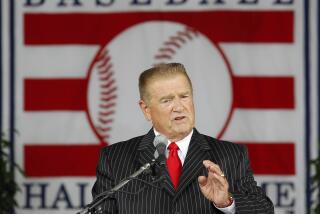Catching Charm, Strength of âGreenbergâ
Firebrand attorney Alan Dershowitz thought this man would be Americaâs first Jewish president. Carl Levin, senator from Michigan, said he validated the American dream. And Walter Matthau joined the Beverly Hills Tennis Club even though he didnât play in the hopes of having the occasional lunch with him. Such was the power and charisma of Henry Benjamin Greenberg, also know as Hammerinâ Hank.
As revealed in âThe Life and Times of Hank Greenberg,â Aviva Kempnerâs warm and intelligent mash note to a man who clearly deserved it, Greenberg was not only the best kind of heroic personality--charming, unassuming, quietly confident--but a legend to two different groups.
To baseball fans, Greenberg had the kind of accomplishments that made his election to the Hall of Fame a formality. A lifetime .313 hitter, he had 183 RBIs in 1937, just one short of the record at that time, and the following year he hit 58 home runs, coming within two of Babe Ruthâs then-record. Baseballâs initial $100,000 earner, he was also the first person to be selected as a league most valuable player at two positions (first base and outfield). And, says Detroit Tiger teammate Charlie Gehringer, if he could select a single player from the sportâs history to be at bat when a run was needed, heâd pick Greenberg over anyone, Joe DiMaggio and Ted Williams included.
To Americaâs Jews, however, Greenberg was more than a great player, he was the baseball Moses. Called the first major Jewish celebrity to be famous for athletic abilities, Greenberg defied the stereotypes of what a Jew could and could not do at a time when Nazism was on the rise and domestic anti-Semitism was being fomented by Henry Ford and Father Coughlin. Not a religious man, he was nevertheless unapologetic about his Judaism, and his determination to be himself at all times and all costs made other Jews feel like giant killers by proxy.
Writer-director-producer Kempner, whose first film (as co-writer and producer) was âPartisans of Vilnaâ about Jewish resistance during World War II, worked 13 years on this affectionate portrait of a very different kind of hero, a 6-foot-4 slugger who swung three bats to warm up and played at a time when, one fan remembers in awe, âno one ever saw a Jew that big.â
The son of immigrant parents who were not initially thrilled to have a potential ballplayer for a son, Greenberg grew up in the Bronx with a thirst for baseball in general and driving in men in scoring position in particular that never left him. âWomen, food, home runs, they were fine,â says someone who knew him. âBut RBIs were the thing he lived for.â
Signed by the Detroit Tigers, Greenbergâs first year in organized ball was with Beaumont in the Texas League, where one teammate was shocked to meet a Jew who did not have horns on his head. This was the early 1930s, when a New York cop who stopped the young man for running a traffic light could insist, âWho in the hell ever heard of a Greenberg being a baseball player?â
In fact, Greenberg was not a graceful player, but he was extremely hard-working, a student of the game given to studying himself obsessively in mirrors until his swing became a potent offensive weapon. âWhen Hank comes up to the plate, Ball, youâre going to be out late,â ran one popular song about his hitting. âGoodbye, Mr. Ball, goodbye.â
Greenberg was just as determined to shrug off the racial slurs that were a constant refrain while he was on the field, with some teams even bringing up especially virulent bigots from their farm teams to ride Greenberg from the bench during crucial series.
The baseball and Jewish sides of Greenbergâs celebrity came together at the end of the 1934 season, when he decided to play on Rosh Hashana, the Jewish New Year, on the advice of a rabbi who is said to have consulted the Talmud before giving his OK. Greenberg hit two home runs, the Tigers won the pennant, and the Detroit Free Press printed âHappy New Yearâ in Hebrew as its headline. When Greenberg sat out the even holier day of Yom Kippur, his stock as a man of principle soared.
Filmmaker Kempner tells this and other tales with the help of rarely seen archival footage, a pair of on-camera conversations Greenberg did a few years before his death in 1985, and nearly 50 other interviews. Some of these, with teammates and family members (include his divorced first wife, department store heiress Caral Gimbel) are expected, while others, like talking to actor Michael Moriarty, the grandson of a man who umpired several of Greenbergâs key games, are fascinatingly not.
In one of the storyâs most potent coincidences, Greenbergâs last year in the majors, 1947, was the first for a young player named Jackie Robinson. The intense razzing Greenberg took paled before what Robinson was to experience, and when the two men literally collided on the field (Greenberg spent his final season in the National League) the older player took the time to give his younger colleague some encouragement. Robinsonâs comments on that moment is an eloquent coda to this involving, heartfelt film. âMr. Greenberg,â he told reporters at the time, âhas class. It stands out all over him.â Indeed it does.
* Unrated. Times guidelines: suitable for all ages.
âThe Life and Times of Hank Greenbergâ
Released by Cowboy Booking International. Director Aviva Kempner. Producer Aviva Kempner. Screenplay Aviva Kempner. Cinematographer Thomas Kaufman. Editor Marian Hunter. Musical director Henry Sapoznik. Running time: 1 hour, 35 minutes.
Nuart Theater, 11272 Santa Monica Blvd., West Los Angeles. (310) 478-6379.
More to Read
Go beyond the scoreboard
Get the latest on L.A.'s teams in the daily Sports Report newsletter.
You may occasionally receive promotional content from the Los Angeles Times.











